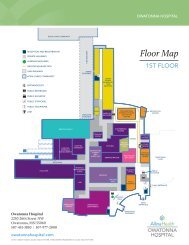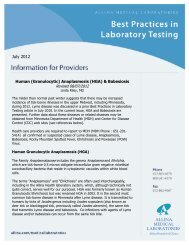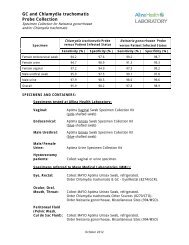Elaine S. Larson Surgical Center Campaign - Allina Health
Elaine S. Larson Surgical Center Campaign - Allina Health
Elaine S. Larson Surgical Center Campaign - Allina Health
You also want an ePaper? Increase the reach of your titles
YUMPU automatically turns print PDFs into web optimized ePapers that Google loves.
obotic removal of Uterine fibroids<br />
jeannette Wittrock’s story<br />
During her annual physical exam, Forest lake resident Jeannette Wittrock<br />
talked with her family physician about her heavy, long menstrual bleeding.<br />
She had uterine fibroids, noncancerous tumors of the uterus, a condition<br />
that often runs in the family. Her symptoms were severe enough to<br />
warrant surgery, so her doctor referred her to gerald Cunniff, MD, a<br />
surgeon who specializes in the robotic treatment of uterine diseases.<br />
Robotic surgery is performed using the advanced technology known as the<br />
da Vinci ® <strong>Surgical</strong> System. The surgeon sits at a console and uses hand<br />
and foot peddles to control four robotic arms that hold micro-instruments<br />
and a miniature camera. The surgeon views the surgery through a<br />
3-dimensional camera that magnifies the view 10 times.<br />
The advantages of the robotic-assisted surgery are improved accuracy,<br />
precision and control for the surgeon and reduced pain, discomfort, blood<br />
loss and side effects for the patient. Studies have shown that roboticassisted<br />
surgery has better outcomes than traditional open surgery.<br />
“The primary advantage of robotic surgery is that it is less invasive,” says<br />
Dr. Cunniff, an obstetrician and gynecologist at <strong>Allina</strong> Medical Clinic –<br />
Parkview OB/gYN in Eagan, Minn. “Because it is less invasive, recovery<br />
time is greatly reduced. In a traditional open procedure, the patient<br />
typically stays in the hospital three to four nights and then has a six-week<br />
recovery before she can return to work. With the robotic procedure, the<br />
hospital stay is usually overnight, and she can return to normal activity in<br />
two to three weeks.”<br />
<strong>Surgical</strong> treatment for uterine fibroids can include myomectomy, removal<br />
of the fibroids themselves, or hysterectomy, removal of the uterus, if the<br />
condition is severe. Because of Wittrock’s condition and symptoms, a<br />
hysterectomy was recommended.<br />
continued on next page<br />
SURgICAl CENTER CAMPAIgN<br />
Patient’s Story<br />
Gerald Cunniff, Md<br />
9
















